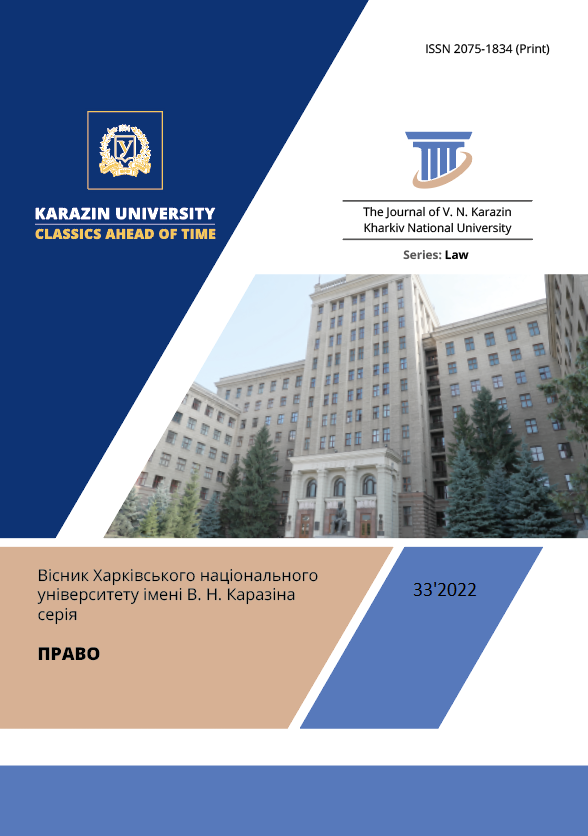Local referendums in the European Union and Ukraine: comparative characteristics
Abstract
Introduction. The article formulates proposals to improve the effectiveness of legal regulation of the institute of local referendum and involvement of citizens in the implementation of local self-government on the basis of comparative legal analysis of the legal regulation of local referendum in the European Union and Ukraine.
Summary of the main research results. In EU countries, unlike national referendums, local referendums are held on the territory of a subject of the federation, autonomous entity, or administrative-territorial unit. Such referendums address issues of local importance. The procedure for legislative consolidation of the local referendum in the EU countries is possible at three levels: constitutional, national legislation, and local. In Ukraine, the normative regulation of local referendums is carried out at two levels: constitutional and legislative levels. Currently, holding local referendums in Ukraine is impossible due to the lack of a special law in this area. The main types of referendums are characterized.
Conclusions. As a result of the analysis, it is proposed that in order to improve the effectiveness of legal regulation of the institute of the local referendum and eliminate the "legal vacuum" in this area, it is necessary to adopt a separate Law "On Local Referendum".
Draft Law No. 5512 "On Local Referendum", which was registered in the Parliament on May 19, 2021, needs to be improved, namely, to regulate the possibility of holding a local referendum both at the municipal (local) level and at the regional level, that is, at the level of the region, district and the Autonomous Republic of Crimea to address issues of common interest to these communities; not all local referendums should be mandatory; the division of local referendums into mandatory and consultative ones may depend on the quorum of participation, for example, if the turnout is 50% percent or more - mandatory, consultative - if the turnout is less than 50%; to solve the problem of financing local referendums, to provide a mechanism for partial compensation of expenses from the state budget
Downloads
References
/References
Загальна теорія держави і права: підручник для студентів юридичних вищих навчальних закладів] / М. В. Цвік, О. В. Петришин, Л. В. Авраменко та ін.; за ред. М. В. Цвіка, О. В. Петришина. –Харків: Право, 2011. 584 с.
SartoriG. Democraziaadefinizioni. 4ed. Bologna, Milano, 1972. 333 p.
Погорілко В. Ф., Федоренко В. Л. Референдне право України: навч. посібник. Київ: Ліра-К, 2006. 366 с.
Референдуми в Європейському Союзі. За ред. Ковриженка Д.С., Лабораторія законодавчих ініціатив. Київ: ФАДА. 2007. 186 с.
Конституція України від 28.06.1996. URL: http://zakon1.rada.gov.ua/laws/show/254к/96-вр.
Про місцеве самоврядування в Україні: Закон України від 21.05.1997 No 280/97-ВР. URL: http://zakon3.rada.gov.ua/laws/show/280/97-вр.
Про добровільне об’єднання територіальних громад: Закон України від 05.02.2015 No 157-VIII. URL:https://zakon.rada.gov.ua/laws/show/157-19#Text
Досвід застосування місцевого референдуму в Україні як складової місцевої демократії. Лабораторія законодавчих ініціатив. Київ, 2016. URL: https://parlament.org.ua/wp-content/uploads/2016/11/pdfjoiner.pdf
Про всеукраїнський референдум: Закон України від 26.01.2021 No 1135-IX. URL: https://zakon.rada.gov.ua/laws/show/1135-20#Text
Про місцевий референдум: проект Закону України No5512 від 19.05.2021. URL: https://www.kmu.gov.ua/bills/proekt-zakonu-pro-mistseviy-referendum
Стешенко Т.В., Пахомов А.В. До проблеми місцевого референдуму: правовий аспект. URL: http://www.lsej.org.ua/11_2021/27.pdf
General theory of state and law. Edited by M.V. Tsvik, V.D. Tkachenko, O.V. Petryshyn. Kharkiv: Pravo, 2011. 584 p.(In Ukrainian)
Sartori G. Democrazia a definizioni. 4ed . Bologna, Milano, 1972. 333 p.
Pohorilko V., Fedorenko V. Referendum law of Ukraine: A textbook. Kyiv:Lira. 2009. 366 p.(In Ukrainian)
Referendums in the European Union. Ed.by Kovryzhenko D.S., Agency for Legislative Initiatives. Kyiv: FADA, 2007. 186 p.(In Ukrainian)
The Constitution of Ukraine of 28.06.1996. URL: http://zakon1.rada.gov.ua/laws/show/254к/96-вр. (In Ukrainian)
On local self-government in Ukraine: Law of Ukraine of 21.05.1997 No 280/97-VR.URL: http://zakon3.rada.gov.ua/laws/show/280/97-вр. (In Ukrainian)
On the voluntary association of territorial communities: Law of Ukraine of 05.02.2015 No 157-VIII. URL: https://zakon.rada.gov.ua/laws/show/157-19#Text/ (In Ukrainian)
Experience of using local referendum in Ukraine as a component of local democracy. Agency for Legislative Initiatives. Kyiv. 2016. URL: https://parlament.org.ua/wp-content/uploads/2016/11/pdfjoiner.pdf/ (In Ukrainian)
On the all-Ukrainian referendum: Law of Ukraine of 26.01.2021 No 1135-IX. URL: https://zakon.rada.gov.ua/laws/show/1135-20#Text/ (In Ukrainian)
On local referendum: draft law of Ukraine No. 5512 of 19.05.2021. URL: https://www.kmu.gov.ua/bills/proekt-zakonu-pro-mistseviy-referendum/ (In Ukrainian)
Steshenko T.V., Pakhomov A.V. To the problem of the local referendum: legal aspect.URL: http://www.lsej.org.ua/11_2021/27.pdf/ (In Ukrainian)

This work is licensed under a Creative Commons Attribution 4.0 International License.




